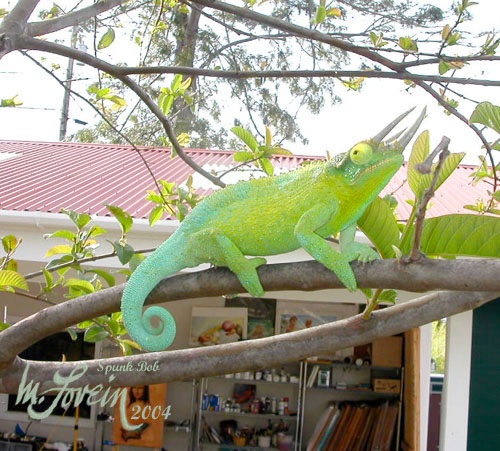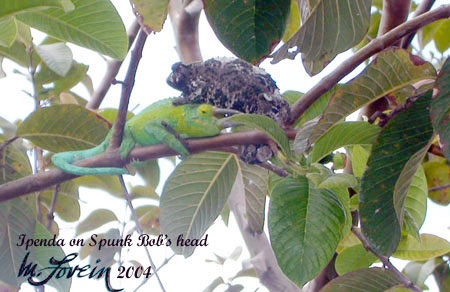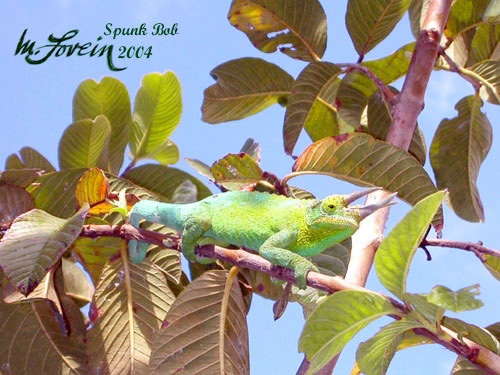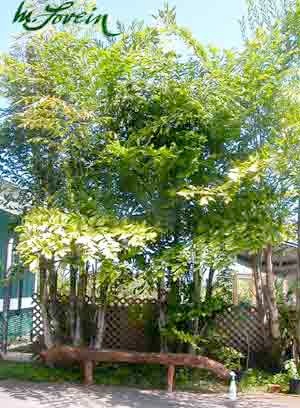



The Story of a Beloved Jackson’s Chameleon
By Matt & Mary Lovein
Citation:
Lovein, M. & M. Lovein (2004). The Story of a Beloved Jackson’s Chameleon. Chameleons! Online E-Zine, May 2004. (http://www.chameleonnews.com/04MayLoveinLovein.html)
Hello E-Zine readers!
Thank you for this opportunity to give you a limited account, from my perspective, regarding Hawaii Jacksonii, living in our midst in a protected and private locale. We are chameleon admirers who do not take their presence for granted. They are the ones in charge and we serve, observe and respect them, always desiring to learn more about these beautiful animals. The more I learn, the more I want to know. The observations offered here are not meant as a scientific reference, but are simply an attempt to share with you, a slice of life, which is enriched with tiny dinosaurs, nature's living sculptures.

My husband, Matt and I are artists, and own a gallery in Holualoa Village on the Big Island of Hawaii. Both of us have open air studios at home, and are fortunate to have daily opportunities to observe Jackson's chameleons in the trees and bushes where we live and work. We photograph and document these little visitors on a regular basis. Many are long time residents and most all of them have names. They are not that easy to spot and it takes practice to look at every branch. I have talked to many neighbors who have never seen even one.
It started with fascination and turned into a passion, making a good lifestyle even better. This is a story about Spunk Bob, who has been entertaining us with his antics and his activities for about a year.
He was brightly colored, when we first spotted him, chartreuse, with an almost airbrush gradation to aqua, lemon yellow eyes and dabs of turquoise, particularly in the gular region and on the tail. We estimated he was around eight months old when we first noticed him. Now, as an adult, he is small in comparison to others his age. He is wiry but quite healthy. Approximately 20 months old, he now weighs about 80 grams.

This is a picture showing Spunk Bob in all his glory and also gives you an idea of how I can observe the Jackson's, while painting. My studio can be seen in the background.
Spunk Bob can be found, most mornings, in his tree. When he disappears, I am not sure where he goes, but he is very active. We don’t see him every day but each time we do see him, is another joyful day for us. We named him Spunky when he took up residence on the palm by our entry way. He could not have picked a place that had more human activity. This is the same location that has been occupied by others in that age group, and usually one at a time. Sometimes there is one little chameleon in each palm on both sides of the front door.

Agitated by his courting, Ipenda sits on Spunk Bob’s head.
We changed his name to Spunk Bob because of his frequent head bobbing. He bobs at everything: at females, at us, and even at food, sometimes so violently that I think he will injure himself. This male has a particularly friendly disposition and has modeled for many photos since he doesn’t seem to be afraid of us or the camera in the least. It is peculiar but he remains still for the click of the shot. This makes him an ideal specimen to photograph.

Spunk Bob stalking the females in his territory
When I come near him, and he is on a lower branch of the tree, he will step onto my head. I can walk with him as an ornament and then return him to the tree. There are many flying insects there to nourish him and the occasional female visitor to keep him interested. Recently, we were sitting on the back steps and he came out of the tree and down onto the concrete walkway, right past our feet, and climbed into the night blooming jasmine. He was on a mission to meet a female, named Ipenda. She is the one that sat on his head when she had enough of his stalking. He doesn’t easily, take no for an answer and continues to pursue her, proudly posing and eagerly bobbing.
Spunk Bob once got into a horn to horn combat with another male which we removed and relocated to another tree. He seems to think that he won that particular encounter and that he is the reigning king of the guava tree. He did receive some battle wounds defending his real estate in that confrontation. I put a little diluted chlorhexadrine on them a few times and they healed up nicely.
A few months ago, during a wind storm, he must have gotten blown out of the tree. We did not see him for awhile but when I was visiting a neighbor almost two acres away, I spotted him! I didn’t remove him though. He was simply too high to reach. One week went by and he showed up again to reclaim his familiar territory and more of the royal treatment to which he has become accustomed.
He looked a little scuffed up. On the left of his dorsal crest, the area appeared black and scraped. On the right rear side of his body was a puncture wound. I think he probably got it from a branch during the high winds. I used Betadine on it, applied just to the center of the wound on two different occasions. His spectacular skin is fine now and he is as spunky as ever.
Each of the residents and visitors I have met are individuals with subtle distinctions in appearance and temperament. The horns are one way of identifying the males. Some are friendly and others are shyer. I have come across only a few with attitude, threatening to bite, but have found that they are easily calmed with a gentle chin rub, though some are never comfortable with any human interaction.
There is another longtime resident male living at the top of the fish tail palms at the end of our driveway along with two adult females. He is Squiggy, named for a little kink in a horn. Occasionally, the palms rain babies and we find the newborns on small branches near the bottom. We also feed the Squiggerts almost every day and they are usually in the same place at the same time in the morning. I call it the feeding station. We have a hunting routine and gather insects as well as keeping crickets on hand for treats. These are offered in a plastic feeding container attached to the end of a long pole. If we are not in our places at the time they are ready to dine, they will go off hunting on their own and we cannot always locate them.

Squiggy's fish tailed palms.
It doesn’t take long to get attached to new arrivals that appear. It is awesome to see them thriving and procreating in their safe haven under nearly idyllic conditions with morning sun and afternoon showers here on the side of Hualalai Mountain, Big Island of Hawaii.
Mahalo and Aloha on line,

Matt & Mary Lovein

Matt and Mary Lovein are gallery owners in Holualoa, Hawaii. He is a ceramic artist and she is a painter. They observe Jackson's chameleons daily, as they live and work from their open air studios at their home. www.lovein.com









Join Our Facebook Page for Updates on New Issues:
© 2002-2014 Chameleonnews.com All rights reserved.
Reproduction in whole or part expressly forbidden without permission from the publisher. For permission, please contact the editor at editor@chameleonnews.com
